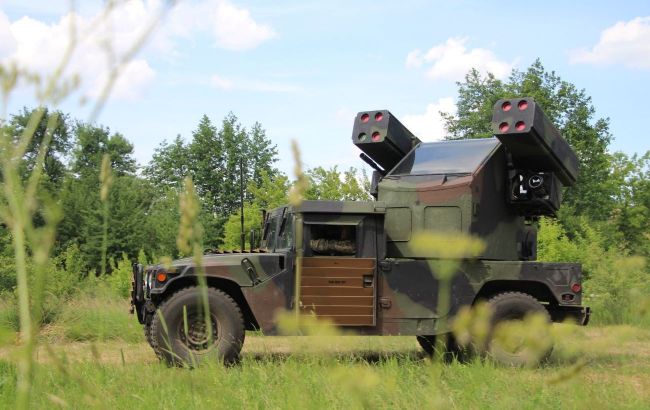Avenger in Ukraine's arsenal: Key features of air defense system and how Armed Forces use it
 Photo: Avenger self-propelled air defense systems in the service of the Armed Forces of Ukraine (facebook.com/UALandForces)
Photo: Avenger self-propelled air defense systems in the service of the Armed Forces of Ukraine (facebook.com/UALandForces)
Ukraine will receive more Avenger self-propelled anti-aircraft missile systems. Additional deliveries were announced on the eve of winter when it is expected that Russia may increase the intensity of missile strikes and drone kamikaze attacks.
More details about the Avenger systems and how they are already defending Ukrainian skies - in the article on RBC-Ukraine.
During the preparation of the article, the following sources were used: Pentagon statements, articles of Foreign Policy, ArmyInform, Ukraine Weapons Tracker analytical project, Defense Express, and the statements of the Joint and Ground Forces Command of the Armed Forces of Ukraine.
The U.S. Department of Defense will allocate another military aid package worth $325 million. In addition to DPICM cluster munitions, anti-tank weapons, HIMARS missiles, ammunition, and automotive equipment, it will include tools to strengthen Ukraine's air defense.
Specifically, 50mm caliber machine guns for countering enemy drones and AIM-9M missiles, which are ammunition for the NASAMS air defense system and can also be launched from combat aircraft. For more information about them, read the recent RBC-Ukraine article "Missiles against Shaheds: How Ukrainian Armed Forces can use AIM-9 and not wait for F-16."
Additionally, an undisclosed quantity of Avenger air defense missile systems is included in the American package. This is far from the first delivery. It is known that Avenger has been used in Ukraine at least since the spring of 2023 and has proven itself well since then.

Photo: Avenger air defense systems were again included in the military aid package for Ukraine (facebook.com/UALandForces)
According to Foreign Policy, the Ukrainian side had been requesting them since October 2022 when Ukraine faced repeated attacks on energy infrastructure facilities several times a week. The transfer of the first four complexes was announced by U.S. National Security Advisor Jake Sullivan on November 10.
Since then, Avengers have appeared in new packages from time to time.
The American "avenger": What is known about the self-propelled air defense missile system
The Avenger air defense system is a joint product of Boeing and General Electric. The first company developed its own self-propelled anti-aircraft missile complex, while the other one - the chassis.
It was introduced in 1990 and has since been in service with the U.S. Army and Marine Corps. Foreign operators include Bahrain, Egypt, Iraq, Saudi Arabia, Taiwan, Chile, and Ukraine.
Avenger provides short-range air defense, up to 5.5 km. It is capable of protecting against cruise missiles, drones, planes, and helicopters at altitudes below 4 km, both head-on and from behind.
The anti-aircraft missile complex is mounted on a high-mobility multipurpose wheeled vehicle (HMMWV). It has two containers with four Stinger missiles each, its own radar station, and a 12.7mm Browning M2 machine gun. Thanks to the built-in thermal imager, operators can detect aerial targets at any time of day and in any weather.
 Photo: Avenger is a development from the late 1980s (facebook.com/UALandForces)
Photo: Avenger is a development from the late 1980s (facebook.com/UALandForces)
Key characteristics
- Target engagement range: from 0.2 to 5.5 km.
- Target engagement altitude: up to 3.8 km.
- Crew: 2 persons (in the basic version)
- Speed: up to 105 km/h
- Range: 440-560 km
- Weight: 3900 kg (total) and 1134 kg (platform)
Regarding armaments, the Stinger missiles have a target range of 200 to 4500 meters. The machine gun can fire at a rate of up to 1200 rounds per minute. The Avenger air defense system uses guidance systems such as an optical sight, laser rangefinder, and the infrared homing head of the missiles.
Avenger has three main modifications: the basic, STC, and Up-Gun. The base version is equipped with a turret mounted on a heavy HMMWV, two Stinger launchers, and the ability to connect to the FAAD C3I air control, command, and reconnaissance system.
The STC modification allows the operator to select targets from the targeting console display and automatically turn the turret toward the target without the gunner. The temporary Up-Gun version was introduced in 2005 for the mission in Iraq, where an additional machine gun was installed instead of one of the missile containers to provide extra protection against ground attacks.
Why Ukraine needs Avenger systems
Ukraine submitted a request for high-mobility Avenger air defense missile systems in the fall of 2022. At that time, similar systems were extremely necessary to protect critical infrastructure against Russian cruise missiles and Shahed drones.
But as analysts from Defense Express note, besides the ability to engage targets with machine guns and anti-aircraft missiles, there is another important feature that can play a significant role in Ukraine's future victory over Russia. This feature is the advanced fire control system. Thanks to it, not only can targets be selected for firing, but data on target designation can also be exchanged with other air defense assets.
 Photo: Avenger air defense system in service with Ukraine (facebook.com/UALandForces)
Photo: Avenger air defense system in service with Ukraine (facebook.com/UALandForces)
In the U.S. military, Avengers are designated to provide air cover for ground forces during marches and protect the positions of Patriot missile defense systems. Therefore, it is not excluded that depending on the priorities of the Armed Forces of Ukraine, they will also use them for such tasks.
However, considering the threat of increased attacks on energy infrastructure in the fall and winter, it is evident that Avenger systems will primarily be used to protect specific objects. Commander of the Joint Forces of the Armed Forces of Ukraine, Serhii Naiev, mentioned this when talking about the complexes deployed in the Northern operational zone.
"They are capable of providing mobile short-range air defense for civilian infrastructure facilities, Security sector units, as well as defense against cruise missiles, drones, aircraft, and helicopters at low altitudes," he emphasized.
How Ukraine uses Avenger systems
Avenger systems first appeared in Ukraine in March 2023. At that time, a video with a self-propelled air defense missile system and Ukrainian military personnel was posted on the Ukraine Weapons Tracker project's Twitter. It was reported that the machines had been delivered from the United States to the German port of Bremerhaven in mid-February. As of March, Ukraine was expected to receive 12 units.
#Ukraine: The first video of the recently delivered American AN/TWQ-1 Avenger short-range air-defense system in service with the Ukrainian army.
— Ukraine Weapons Tracker (@UAWeapons) March 18, 2023
In total Ukraine will receive 12 of these vehicles from the United States. pic.twitter.com/1Kivu2zG8F
In April, the Joint Forces Command of the Armed Forces of Ukraine posted a video about the Avenger systems on active duty.
"The guys who trained on this system underwent training in Germany. They are fully prepared to operate it," said Serhii Naiev.
Members of one of the crews explained that thanks to the built-in thermal imager, they can operate both day and night. The operator-gunner demonstrated the features of operating the turret from a remote control panel. According to him, turret control can be done either from the turret itself or from the control panel. Initially, the target is tracked on a special screen, after which the optical sight is deployed, and the gunner uses it to lock onto the airborne target.
Additionally, the crew manages to fully prepare the complex for combat duty while traveling from the base camp or waiting area. Thanks to the passive radar station, the enemy cannot detect the Avenger. General Naiev also adds that the equipment is very simple and easy to operate.
In June, the press service of the Ground Forces of the Armed Forces of Ukraine reported on the successful use of self-propelled air defense missile systems.
"These complexes have already proven their effectiveness in destroying Shaheds and Russian missiles," Ukrainian military officials noted.

